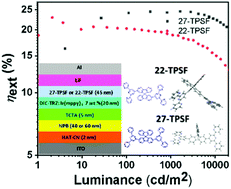Positional isomerism effect of spirobifluorene and terpyridine moieties of “(A)n–D–(A)n” type electron transport materials for long-lived and highly efficient TADF-PhOLEDs†
Abstract
Combining rigid twisted spirobifluorene with two strongly electron-withdrawing terpyridine moieties to form a “(A)n–D–(A)n” structure is an effective way to achieve electron transport materials (ETMs) with high triplet energy, suitable frontier orbital levels, excellent thermal stability and electrochemical stability for long-lived and highly efficient organic light-emitting diodes (OLEDs), 2,2′-di([2,2′:6′,2′′-terpyridin]-4′-yl)-9,9′-spirobi[fluorene] (22-TPSF) and 2,7-di([2,2′:6′,2′′-terpyridin]-4′-yl)-9,9′-spirobifluorene (27-TPSF), both of which are better than the conventional ETM 1,3,5-tris(N-phenylbenzimidazol-2-yl-benzene (TPBi). In addition, the crystal packing mode in their single crystals undergoes a significant transformation from the sandwich arrangement of 22-TPSF into the brick wall arrangement of 27-TPSF, causing a big difference in electron transport mobility, which changes from 0.012 to 0.104 cm2 V−1 s−1 as calculated through density functional theory. This variation leads to a phenomenon where the 22-TPSF based devices display a lower maximum external quantum efficiency of 22.9% and a shorter half-life (T50) of 173 925 hours at an initial luminance of 100 cd m−2 than the 27-TPSF based devices. These findings highlight the great potential of the ETM structured as “(A)n–D–(A)n” using the terpyridine and spirobifluorene moieties; moreover, the positional isomerism effect allows remarkable tuning of the electron transport mobility and makes an obvious influence on OLED performance and lifetime.



 Please wait while we load your content...
Please wait while we load your content...